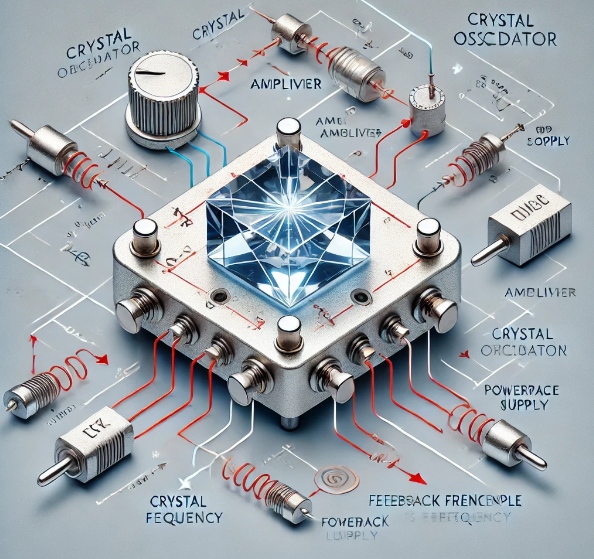What is the Working Principle of a Crystal Oscillator?
Oct 22, 2024
A crystal oscillator is an electronic circuit that utilizes the mechanical resonance of a vibrating quartz crystal to create a consistent electrical signal at a precise frequency. This technology is used in a wide range of applications, from watches to telecommunications, and its ability to provide a stable, reliable signal makes it invaluable in many industries.
The Structure of a Crystal Oscillator
At the core of a crystal oscillator is a quartz crystal. Quartz is a piezoelectric material, meaning it generates an electric charge when subjected to mechanical stress. Conversely, when an electric field is applied, the crystal deforms, creating mechanical vibrations. This two-way relationship between electrical energy and mechanical vibration is central to how a crystal oscillator works.
The quartz crystal in the oscillator is cut in a specific way to resonate at a particular frequency when a voltage is applied. These vibrations are used to generate an alternating current (AC) signal. The frequency of this signal depends on the physical dimensions and cut of the crystal, which allows for very precise and stable oscillation.
How Crystals Work in Oscillators
The working principle of a crystal oscillator revolves around its ability to maintain a stable frequency due to the physical properties of the quartz crystal.
Piezoelectric Effect: When a voltage is applied to the quartz crystal, it begins to vibrate at a specific frequency. These vibrations are caused by the piezoelectric effect, where mechanical stress and electric fields interact.
Resonance: The crystal is designed to vibrate at its natural resonant frequency. This frequency is determined by the crystal's shape, size, and cut. The vibrations create an electrical signal that oscillates at a stable frequency.
Feedback Loop: The signal generated by the crystal is amplified and fed back into the circuit. This feedback ensures that the oscillations continue, creating a steady, consistent signal. This is essential for applications where precise timing and frequency are required, such as in clocks or communication systems.
Amplification: The oscillating signal from the crystal is relatively weak, so it is typically amplified to be usable in practical circuits. The combination of the crystal's natural oscillation and amplification creates a highly stable output.
Why Crystal Oscillators are Important
Crystal oscillators are essential in a variety of electronic devices because of their ability to generate a stable and accurate frequency. Some common applications include:
Timekeeping Devices: Quartz watches are perhaps the most well-known application of crystal oscillators. The quartz crystal ensures that the watch keeps accurate time by oscillating at a precise frequency.
Microprocessors: In computers and other digital devices, crystal oscillators are used to provide the clock signals that synchronize operations within the processor. The stable oscillation allows for consistent processing speeds.
Telecommunications: Crystal oscillators are critical in devices like radios and mobile phones, where they help generate the carrier frequencies necessary for transmitting and receiving signals.
Piezoelectric Quartz Crystal: This keyword emphasizes the importance of the piezoelectric effect in generating the oscillations needed for stable frequency generation.
Frequency Stability in Crystal Oscillators: This keyword relates to the main advantage of using crystal oscillators—their ability to maintain a stable frequency over time and under varying conditions.
Quartz Oscillator Circuit Design: A term that refers to the electronic circuits designed around the quartz crystal to ensure proper feedback, amplification, and frequency control.
Factors Influencing Crystal Oscillator Performance
Several factors can influence the performance and accuracy of crystal oscillators:
Temperature: Quartz crystals are sensitive to temperature changes, which can slightly alter their resonant frequency. This phenomenon is called temperature drift. To minimize the effect of temperature on frequency stability, some oscillators are designed as temperature-compensated crystal oscillators (TCXOs).
Aging: Over time, quartz crystals can experience small changes in their physical properties, leading to frequency drift. Aging is typically slow, but it can have long-term effects on frequency accuracy. High-quality oscillators are designed to minimize aging effects.
Load Capacitance: The load capacitance of the circuit connected to the crystal can influence its resonant frequency. Careful circuit design is required to ensure that the crystal operates at its intended frequency.
Mechanical Stress: Physical stress on the crystal, such as shocks or vibrations, can affect its performance. For critical applications, oscillators are often enclosed in protective casings to shield the crystal from external stresses.
There are different types of crystal oscillators, each designed for specific applications:
Standard Crystal Oscillators (XO): These are the most common type, used in general-purpose applications where extreme precision is not required. They are widely used in everyday electronics such as clocks and radios.
Temperature-Compensated Crystal Oscillators (TCXO): These oscillators are designed to maintain a stable frequency over a range of temperatures. They are commonly used in outdoor or mobile applications where temperature fluctuations could otherwise degrade performance.
Voltage-Controlled Crystal Oscillators (VCXO): In this type, the frequency of oscillation can be adjusted by varying an external control voltage. VCXOs are used in communication systems where precise frequency tuning is needed.
Oven-Controlled Crystal Oscillators (OCXO): These oscillators are housed in a temperature-controlled oven to keep the crystal at a constant temperature, ensuring maximum frequency stability. They are used in high-precision applications like GPS systems and scientific instruments.
Understanding the working principle of a crystal oscillator is crucial for appreciating its role in modern electronics. Quartz crystals, through the piezoelectric effect, produce highly stable oscillations that can be used to generate precise frequencies. These oscillators are found in everything from watches to communication systems, and their reliability makes them a cornerstone of electronic design.If you need a high-quality crystal oscillator for your application, please feel free to contact us. Shenzhen Jingguanghua Electronics Co., Ltd. is committed to providing a one-stop crystal procurement solution to ensure that your procurement process is both efficient and convenient.
Read More

